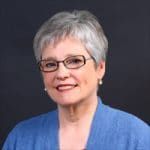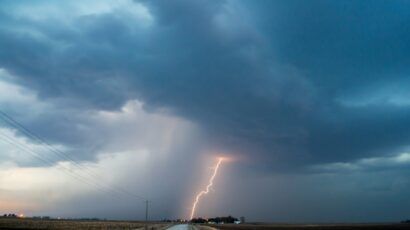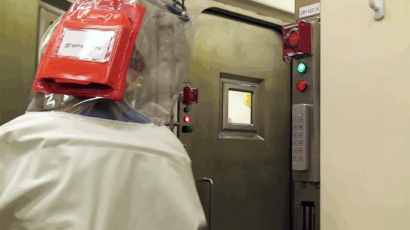Science, art, and the legacy of Martyl
By Kennette Benedict | April 9, 2013
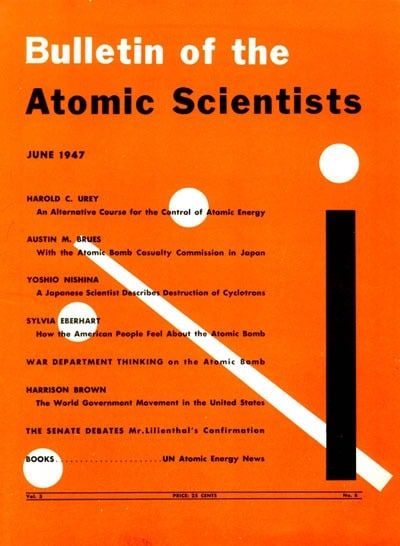
Martyl Langsdorf, the artist who created the Doomsday Clock, died on March 26th at the age of 96 in Chicago. Known to many friends and fans simply as Martyl, she was a petite and vivacious woman who had an outsize influence on public consciousness about nuclear weapons through her design of the clock that first graced the cover of the Bulletin of the Atomic Scientists in 1947, and continues to be used today.
Born in St. Louis, Missouri in 1917, Martyl Suzanne Schweig married Washington University physicist Alexander Langsdorf, Jr. in 1941, and came with him to the University of Chicago when he joined Enrico Fermi’s group to work on nuclear fission.
Based on Fermi’s research and the engineering work of the university’s metallurgical laboratory, headed by John Simpson, the Manhattan Project would soon produce the first atomic bomb. Yet even as they were completing their designs for the weapon, scientists at Chicago — notably chemistry Nobel laureate James Franck, physicist Leo Szilard, and Eugene Rabinowitch, a biologist and one of the first editors of the Bulletin of the Atomic Scientists — had grave reservations about using the weapon on civilians. So in 1945, as they realized the terrifying significance of the United States’ plan to drop these bombs on Hiroshima and Nagasaki, they began organizing meetings to debate and discuss their invention. Their arguments spilled out beyond labs and classrooms into dining rooms in private homes and onto platforms in public halls. Sometimes heatedly, and always passionately, they spoke of the role and responsibility of the scientific community in creating the most dangerous technology on Earth.
Like many others in the university community, Martyl was in the thick of these discussions. So when the founders of the Bulletin of the Atomic Scientists at the University of Chicago decided to make the newsletter into a magazine in 1947, co-editor Hyman Goldsmith asked Martyl if she would draw a design for the cover. He and co-editor Rabinowitch couldn’t pay her much, but she thought it might be fun to help out. She also guessed that she was “the only artist they knew.”
Martyl first considered using the letter U, the chemical symbol for uranium, as her design. As she listened more intently to their conversations, though, she soon realized that it was the atomic scientists’ urgency about the looming dangers of this new technology that was most compelling. So she drew the hands of a clock ticking down to midnight. Like the countdown to an atomic bomb explosion, it suggested the destruction that awaited if no one took action to stop it.
Martyl created a substantial body of artwork over the years, and would sometimes chuckle about how she came to be known as the “clock lady,” bemused by all the attention for a simple drawing. But I think she also came to enjoy the recognition she won for creating one of the most significant graphic designs of the 20th century.
Martyl became art editor of the Bulletin, illustrating issues and persuading her artist friends to contribute their drawings as well, “for pennies,” as she put it. She thought the eye needed a rest from the text-heavy pages with news about atomic energy, Soviet and US nuclear bomb tests, government secrecy, and the ethics of conducting scientific research for the military.
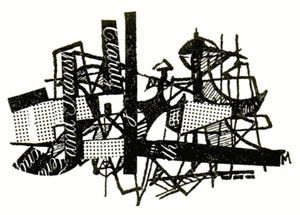
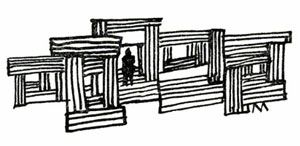
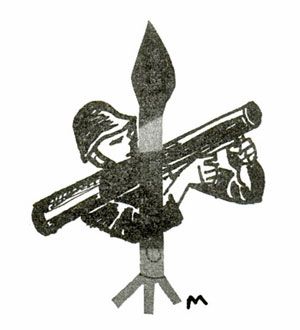
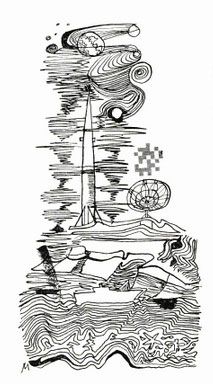
While the drawings and designs in the Bulletin added humor and visual appeal, the publication also reflected a deeper connection between art and science through the quality of the writing, the expressiveness of the authors, and the continuous use of the Doomsday Clock to “exploit the wonderful capacity of the human mind to comprehend wholes without seeing the parts,” as Martyl wrote on page 51 of the February 1959 issue. Her clock design conveyed the state of nuclear danger with exquisite economy; the editors appealed to both the heads and hearts of their readers.
The February 1959 issue, titled “Science and Art” and co-edited by Martyl and University of Chicago metallurgy professor Cyril Stanley Smith, drew an explicit connection. In the introductory essay, they compared the work of artists to that of scientists, suggesting that “the artist is concerned principally with complex relationships and depends on active participation of his audience in developing the pattern,” while the scientist lays out results with simple precision so that the audience can understand an aspect of the world.
To this day, the Bulletin seeks participation by scientists, artists, writers, policy makers, and interested citizens to lead an intelligent debate about the mind-numbing, often horrifying, problems of nuclear and climate change catastrophe. To move past the numbness and provoke action, the Bulletin draws on art and design to create new ways of feeling, just as it taps science for new ways of knowing. In large measure, this is Martyl’s legacy.
A constant presence in the Bulletin community, Martyl was a spirited, outspoken force among the likes of Fermi, Simpson, Szilard, Fermilab director Robert R. Wilson, and Nobel physicist Leon Lederman. She invited them and their families to her family’s home for dinners and parties. She came to know their foibles and quirks in the close-knit community of Chicago scientists and intellectuals during the 1940s, 1950s, and 1960s, and she also understood that these brilliant scientists, for all their genius and wisdom, wrestled with their own demons as they sorted out their reactions to the Bomb.
As much as the Bulletin community loved Martyl, she loved the young journalists and art designers who worked for it. Many of us spent hours at her home and studio, where her poodles, Atom, Xander, and Piper were always ready to greet us, where the bar was always open, where the blooming of her peonies was reason enough for a party, and where the next good story usually started with, “Now, you remember . . .”
Yes, Martyl, we will remember.
Together, we make the world safer.
The Bulletin elevates expert voices above the noise. But as an independent nonprofit organization, our operations depend on the support of readers like you. Help us continue to deliver quality journalism that holds leaders accountable. Your support of our work at any level is important. In return, we promise our coverage will be understandable, influential, vigilant, solution-oriented, and fair-minded. Together we can make a difference.
Topics: Columnists, Nuclear Energy, Nuclear Weapons
